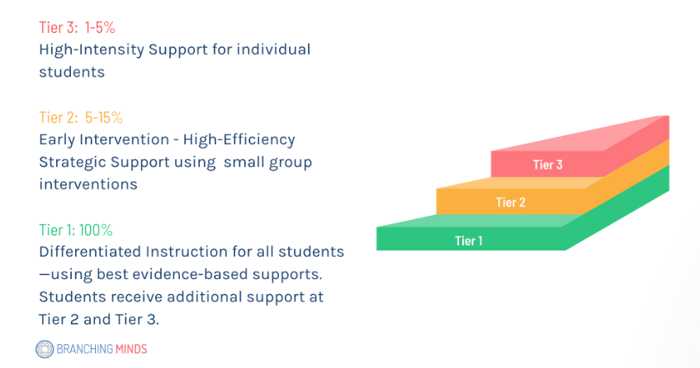Resource shortages have long been at the forefront of the educational paradox of how to maximize student achievement and well-being while staying within the boundaries of school budgets. With the current context of teacher shortages and a need for holistic student support, it is a pertinent issue needing resolution for many of you, our educational leaders. So, what if there was a strategy to identify student needs, assess curriculum and resources transparently, and boost student achievement equitably? There is, and it is called MTSS!
A Multi-Tiered System of Supports (MTSS) allows us to use data in concert with a collaborative problem-solving approach. This combination provides educators with the tools necessary to create student-centered solutions that are both comprehensive and sustainable, paving the way for long-term success.
Understanding the MTSS Triangle
At the core of an MTSS system, universal screeners are utilized across academic and wellness domains (including behavioral and socio-emotional aspects) three times annually to assess where students' skills are lacking. Using the collected data, students are allocated to a support tier based on cut-off scores derived from assessment guidelines and best practices.
Historically, the suggested rule of thumb for support across tiers has been represented by the 80-15-5 triangle. In this model, all students (100%) receive differentiated instruction at the Tier 1 level, which should be sufficient for most students, with at least 80% of students successfully meeting learning objectives. Students demonstrating a need for more strategic or intensive support are provided layered interventions in addition to the core instruction tailored to their skill needs at Tier 2 (15%) and Tier 3 (5%) levels (as seen in the model below).

One common misconception is that only 20% of students can receive intervention support under this model. In reality, the triangle should accurately denote how supports are allocated, even if that means far more than 20% of students are in need of additional support. Consistent and accurate tiering allows educators and leaders to determine if their instruction effectively meets student needs.
How Equitable Tiering Supports Student Achievement and Maximizes School Resources
In the tiering process, an 80-15-5 model is prioritized to build sustainability in your MTSS system. Remember being a child playing with a hand mold impression? If you put all your weight on one of the needles over time, the pressure from that one point would be unbearable. Yet, when you can spread the weight across your hand, you distribute the pressure among multiple needles and can hold your hand there without pain. MTSS tiering operates similarly. Through tiering, you are sustainably able to distribute support and resources for students in an equitable manner that holds the system together. So how, as an educational leader, do you support this process?
1. Build Transparency, Communication, and School Culture Through Data Processes
As an instructional coach and educational consultant, I have worked with school leaders in debunking the myth that collecting data and utilizing a tiering model will generate more confusion for educators. The truth is, proper data collection and analysis can help us avoid blaming and finger-pointing when students fail to meet expectations. Implementing an MTSS system that provides clear outlines for tiering, data analysis, and problem-solving removes these hurdles. Open dialogue around the insights gained from tiering promotes collaboration and encourages positive adult behaviors, all aimed at supporting our students.
2. Evaluate the CORE Health of Your System
After administering your universal screeners, you need to assess the health of your core, Tier 1, programming. Ideally, 80% of students should be meeting expectations across the board at this level, with adequate differentiated supports in place. This provides leaders with a clear goal to evaluate the effectiveness of their current instruction and differentiated processes. Remember, tiering is not for evaluative purposes, but to provide insights into what support our students need to meet expectations.
We have to embrace the direct insights into our core programming that accurate tiering provides us. Only then can we build differentiated supports in a meaningful way to address skill deficits.
3. Align School Resources (e.g., time, personnel, space)
After carefully evaluating core health, leaders can then focus their attention on the alignment of school resources across tiers. The 80-15-5 model provides a guide for where resources should be allocated. The reality is that schools cannot adequately resource support long-term at Tier 2 and Tier 3 levels if too many students (>20%) demonstrate needs in those areas. This might leave us wondering . . . what do we do?
- Resource Mapping: Identify the resources you DO have. Resource mapping is a wonderful tool for capturing all that is available for support on your school campus. Outlining ALL resources is beneficial in this process (i.e., scheduling, facility usage, personnel, curricular materials) to have a clear picture of what is available for addressing needs identified by universal screening, as well as what we need to identify further.
- Goal Setting: A full multi-tiered system of supports takes years to build (that is ok!). Based on the trends you noticed from reviewing core health, you can utilize the 80-15-5 triangle to bring attention to the needs that should be addressed first. Setting intentional goals around how MTSS processes will be implemented on your campus is essential to aligning resources in a meaningful way.
- Problem-Solving and Implementation: Now that you have identified the resources you have, trends seen from the evaluation of your core health, and have set goals…you can take action! It is essential to answer to determine the details of HOW here before allocating resources. For example, if you see that 60% of students are not currently meeting expectations in writing an analytical paragraph (former middle school teacher here!), you may decide to develop a protocol for writing for students at the Tier 1 level. This will require:
- Allocation of time and personnel to identify or develop the tool
- Training and coaching for educators on how to group/teach students in this setting
- Methods to monitor student progress on the skill
Remember that the goal of the MTSS is to create better outcomes for all students. As educational leaders, your task is to support equitable learning, allocate resources for the best outcomes possible, and build a positive school culture. The insights gained from accurate tiering and the 80-15-5 model can help set proactive goals, distribute resources equitably, and support students holistically. Remember, building a sustainable system takes time, but every journey begins with a single step. Tiering is that starting point.
|
Key takeaways from this article:
- A Multi-Tiered System of Supports (MTSS) uses data and collaboration to identify student needs and allocate resources efficiently, promoting equitable and sustainable student success.
- Students should be accurately tiered for support, even if those needs don’t fit within the ideal 80-15-5 model.
- A transparent, data-driven culture in schools facilitates open communication and problem-solving.
- Through evaluating core instruction and aligning resources, the MTSS model provides insights for a more effective allocation of resources, leading to improved educational outcomes for all students.
|
|
|
|
 Make Your MTSS Easy, Efficient, and Effective With the Branching Minds Web Platform Make Your MTSS Easy, Efficient, and Effective With the Branching Minds Web Platform
Transform your district's MTSS solution with personalized intervention plans, powerful collaboration tools, and easy-to-understand reporting. We are more than just a platform, we are a system-level partner

|
Citations
McCart, A., & Miller, D. (2020). Leading Equity-Based MTSS for All Students. Corwin.
Comments (0)